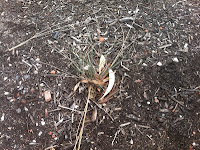Amazing - our plantings on the South-West site are looking incredible after only six months and a long, dry summer, helped in no small part by local residents stopping to pull the odd weed week after week. Thanks to everyone who continues to look out for the success of these plantings.
 |
| February 2011 |
 |
| September 2012 |
 |
| May 2013 |
The late Spring 2012 plantings in the Indigenous Garden have taken a real beating over the 2013 Summer - extra waterings from both Council and Noleema Services have kept everything basically alive, but a very dry Autumn sure hasn't helped. That said, it's not all bad news - we're looking at around a 60% survival rate, and a lot of specimens are coming back either from their own rootstock or from seed. Here are some samples of what you can find sprouting on site if you take the time to look closely:
 |
| Tufted Bluebell (whalenbergia communis), resprouting from rootstock |
 |
| A more advanced Tufted Bluebell |
 |
| A Drooping Cassinia, or "Chinese Scrub," sprouting from seed (cassinia arcuata). We didn't even plant this one - a hardy plant indigenous to the Merri area that has held on tight along the train line and has taken the opportunity presented by a freshly exposed site to sprout from seed and claim back some territory. |

 |
| Chocolate Lillies (dichopogon strictus), resprouting from root stock |
 |
| Old Man's Beard (clematis microphylla), hanging on tight |
 |
Native Spear Grass (austrostipa scabra ssp falcate),
resprouting from root stock |
 |
| Wallaby Grass (austrodanthonia caespitosa), resprouting from rootstock |
 |
Nodding Salt Bush (einadia nutans), sprouting from seed. A vigorous groundcover for
difficult sites and a fantastic fodder plant for local fauna - sweet red berries. The leaves are salty. |
It can be tricky working out what's native and what's exotic at this early stage - personally I'm still going crosseyed trying to identify wallaby grass from buffalo or any other introduced species - but once these get going it will become quite clear. A good soak over Winter will give this site a much needed boost and with some infill planting we should see some decent results come late Spring.












